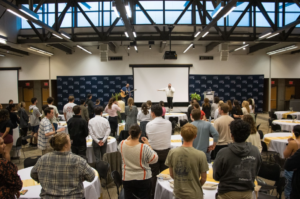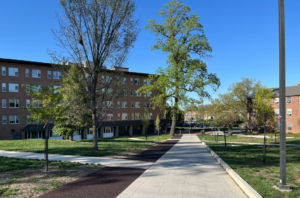Renowned Biologist Discusses Stem Cell Research
By Lindsey Valancius
When explaining something complex like cellular biology, cellular biologist Rick Horwitz equates a cell to a football team. The genes and molecules represent a football roster because they predict cellular activity. The molecular structure and interactions of the cell are similar to the techniques and plays assigned to each football position.
Horwitz compared the life cycle of a cell to what happens when the snap is passed and the football play has begun. Both in the cell and on the field there is constant activity. Different parts of the cell carry out different functions simultaneously. Scientists are still unsure what the visual of all these cellular activities happening at once looks like. That is why the Allen Institute for Cell Science is doing research to provide live footage of cellular components working together to create cellular movement.
Horwitz described the revolutionary work of the Allen Institute for Cell Science in creating 3D cell imagery during his keynote speech at the Biology Department Symposium in the Pryzbyla Great Rooms on Friday, October 12.
In 2014, Horwitz was approached by the recently deceased Paul Allen, cofounder of Microsoft, to become the executive director of his newly launched Allen Institute for Cell Science.
The mission of the Allen Institute is to create realistic images of human stem cells. This imaging requires the collaboration of experts from science realms such as computer science to biology. The Allen Institute posts their imaging data to their website so that independent researchers can use it.
During his slideshow presentation, Horwitz displayed some of the images that his team have developed which was met with “oohing” and “ahhing” from the crowd.
As the Institute’s website states, these data images have been used by independent researchers to study diseases ranging from Alzheimer’s to drug abuse to eating disorders.
This willingness to share their research with the world is part of the Institute’s mission towards open science, the idea that research organizations should be transparent about the research they conduct and the results they collect. Another example of the Institute’s openness is that its headquarters in Seattle can be toured by visitors.
Horwitz is a prominent name in the field of cellular biology. After receiving his doctorate from Stanford University, Horwitz went on to conduct postdoctoral research at University of California Berkeley. He has worked as professors at the University of Pennsylvania School of Medicine and, most recently, the University of Virginia School of Medicine. Horwitz has dedicated his life to the study of cellular migration.
For Horwitz, the ability to create realistic cellular images for research is crucial to the advancement of modern science since “imaging and seeing is believing.”
This speech was the culminating event of the annual day-long symposium hosted by the biology department to highlight the research conducted by current graduate students. The symposium also included talks given by graduate students, a luncheon, and a poster presentation. The speech was attended by graduate students, faculty members, and current undergraduate students. Many students taking biology courses that meet on Fridays were given extra credit if they attended the lecture.








